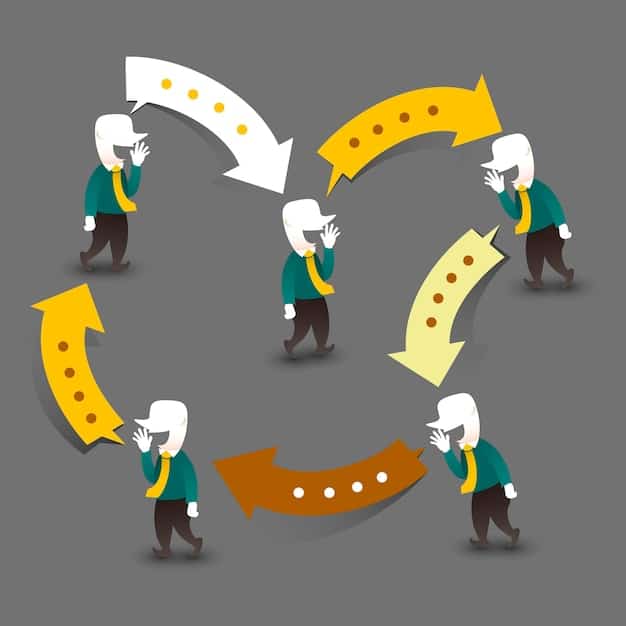The Power of Habit: Your 90-Day Guide to Positive Change

The Power of Habit: How to Create Positive Habits and Break Negative Ones in 90 Days explores a structured approach to habit formation and change, leveraging the science of habit loops and practical strategies for lasting personal growth.
Want to transform your life? Understanding the power of habit: how to create positive habits and break negative ones in 90 days can be your key. It’s not about instant results, but a structured journey towards lasting change.
Understanding the Habit Loop
The habit loop is the cornerstone of understanding how habits form and how to change them. It consists of three elements: a cue, a routine, and a reward. By understanding each component, you can begin to manipulate the loop to create positive
habits and break bad ones.
Identifying the Cue
The cue is the trigger that initiates the behavior. It can be a time of day, a location, an emotion, or even the presence of certain people. Identifying your cues is the first step to changing your habits.
The Routine: Your Behavioral Response
The routine is the behavior itself. It can be physical, mental, or emotional. This is the action you take following the cue, and it’s the part of the habit loop that’s most visible.
- Recognize your current habits and their associated routines.
- Journaling can help track when and how often habits occur, uncovering cues.
- Be specific; don’t just note “I snack,” detail the time, location, and your emotional state.

The Reward: Reinforcing the Habit
The reward is the payoff you receive after completing the routine. This reward reinforces the behavior, making you more likely to repeat it in the future. Rewards are what make habits sticky, so understanding them is crucial.
In order to change your habits, you must identify the reward that drives the habit. Sometimes, the reward is obvious, like the sugar rush after eating a candy bar. Other times, it’s more subtle, like the feeling of accomplishment after completing a workout.
In conclusion, understanding the habit loop is the basis for transforming your habits and your life. By identifying and manipulating the cue, routine, and reward, you can begin to create positive habits and break negative ones.
Setting Realistic Goals for Habit Change
Setting realistic goals is crucial for successful habit change. Overly ambitious goals can lead to discouragement, while setting goals that are too easy may not provide enough motivation. Finding the right balance is key to seeing progress.
Start Small
Break your goals down into smaller, manageable steps. Instead of aiming to run a marathon immediately, start with a goal of running for 20 minutes three times a week. Small successes build momentum and confidence.
Focus on One Habit at a Time
Trying to change too many habits at once can be overwhelming and unsustainable. Choose one habit to focus on initially, and once you’ve made progress, you can add another one. This approach allows you to concentrate your energy and increase your chances of success.
- Prioritize which habits will have the greatest impact on your life.
- Avoid multitasking habit changes; focus intensely on one at a time.
- Celebrate small wins to build momentum and motivation.
It’s vital to keep track of your advancement towards the goals you set. Use a journal, calendar, or app to record your daily progress. This not only provides a visual representation of your success but also helps you identify patterns and potential roadblocks.
In conclusion, setting realistic goals isn’t just about avoiding failure, it’s about setting yourself up for success. Take the time to reflect on what you want to achieve and create a plan that feels both challenging and attainable. Focus on the journey, celebrate small wins, and remember that consistency is more important than perfection.
Leveraging the Power of 90 Days
The 90-day timeframe is often cited as a benchmark for establishing new habits. While habit formation is a complex process that varies from person to person, using a 90-day plan can provide structure and motivation.
Why 90 Days?
Ninety days is long enough to see tangible results and establish a new routine. It’s also a manageable timeframe that doesn’t feel too daunting. The length of the period allows for consistent action while offering a realistic and achievable target.
Creating a 90-Day Plan
Develop a structured plan with specific actions and milestones. Break down your overall goal into weekly and monthly targets. This helps you stay on track and make adjustments as needed.
- Define specific, measurable, achievable, relevant, and time-bound (SMART) goals.
- Create a detailed schedule, allocating time for habit-related activities.
- Plan for potential setbacks and how you’ll address them.
Tracking Progress and Staying Accountable
Keep a detailed record of your progress to monitor your performance. Use tools like journals, apps, or spreadsheets to track your daily, weekly, and monthly achievements. Regular monitoring helps you identify areas where you might be struggling and allows you to make necessary adjustments.
Find an accountability partner or join a support group. Sharing your goals and progress with others can provide additional motivation and support. Knowing that someone else is tracking your progress can make you more committed to sticking to your plan.
In conclusion, using a 90-day plan helps to give you a structured journey towards habit change. The ability to track your progress also keeps you motivated and focused on realizing your 90-day goal.
Breaking Negative Habits: A Step-by-Step Guide
Breaking negative habits is an essential aspect of personal growth. It requires conscious effort, self-awareness, and a strategic approach. Here’s a step-by-step guide to help you break free from unwanted habits.
Identify the Root Cause
Understand what triggers your negative habit. Identify the cues, routines, and rewards associated with the habit. This self-awareness is the first step toward breaking the cycle.
Replace, Don’t Just Eliminate
Instead of simply trying to eliminate the negative habit, replace it with a positive one. For example, if you want to stop snacking on junk food, replace it with a healthier alternative like fruits or nuts. Replacing offers a substitute that can fulfill the same need without the negative consequences.

- Monitor and log your negative habits to uncover patterns.
- Find healthier, alternative behaviors that provide similar rewards.
- Enlist support from friends or therapists for added accountability.
Create Obstacles and Remove Temptations
Make it more difficult to engage in the negative habit by creating obstacles. For instance, if you want to reduce your screen time, hide your phone or use apps that limit your access. Removing temptations from your environment can significantly reduce the frequency of the habit.
Seek support from friends, family, or a therapist. Having someone to talk to and hold you accountable can make the process easier. Support groups can also provide a sense of community and shared experience, which can be incredibly helpful.
In conclusion, breaking negative habits is a journey that requires persistence, patience, and self-compassion. By identifying the triggers, replacing negative actions with positive ones, and seeking support, you can break free and clear the path for personal growth.
The Role of Mindfulness in Habit Change
Mindfulness plays a crucial role in habit change by increasing awareness and fostering conscious decision-making. By practicing mindfulness, you can become more attuned to your thoughts, feelings, and behaviors, giving you greater control over your habits.
What is Mindfulness?
Mindfulness is the practice of paying attention to the present moment without judgment. It involves focusing on your thoughts, feelings, and bodily sensations as they arise, without getting carried away by them.
Mindfulness Techniques for Habit Change
Incorporate mindfulness techniques into your daily routine. Meditation, deep breathing exercises, and mindful walking can help you become more aware of your thoughts and emotions. These exercises increase your self-awareness and presence.
- Start with short, daily meditation sessions to improve focus.
- Practice deep breathing to manage stress triggers that lead to bad habits.
- Engage in mindful eating, paying attention to each bite to reduce overeating.
Mindfulness helps you identify triggers and make conscious choices. When you feel the urge to engage in a negative habit, take a moment to pause and observe your thoughts and feelings. Instead of reacting automatically, make a conscious decision about how to respond.
Develop a habit of self-reflection. Regularly assess your progress, identify areas where you’re struggling, and adjust your strategies accordingly. Self-reflection promotes learning and continuous improvement, helping you stay on track toward your goals.
In conclusion, mindfulness is a powerful tool for habit change. It increases self-awareness, reduces reactivity, and helps you make conscious choices. By incorporating mindfulness techniques into your daily routine, you can gain greater control over your habits and live a more intentional life.
Maintaining Momentum and Preventing Relapse
Maintaining momentum and preventing relapse are essential for long-term habit change. Even after you’ve successfully established new habits, it’s important to stay vigilant and proactive to avoid slipping back into old routines. Develop a plan or strategy that will ensure lasting results.
Celebrate Milestones and Reward Progress
Recognize and celebrate your achievements along the way. Rewarding yourself for reaching milestones can provide additional motivation and reinforce your new habits. Small celebrations can reinforce the satisfaction related to changing and achieving your goals.
Build a Support System
Maintain connections with your support network. Continue to communicate with your accountability partner, friends, or therapist. Sharing your challenges and successes can help you stay on track and prevent relapse. The support network also reassures that you are not alone in realizing and changing your habits.
- Set regular checkpoints to evaluate your progress and adjust accordingly.
- Join communities or forums for continuous encouragement and advice.
- Focus on the compounding benefits of your new habits for motivation.
Relapses are a normal part of the habit change process. If you slip up, don’t be too hard on yourself. Acknowledge the setback, learn from it, and get back on track as soon as possible. Remember, it’s not about perfection, but consistent effort and resilience.
Continually seek opportunities to grow and improve. The journey of habit change is ongoing. Embrace new challenges and continue to refine your habits to align with your evolving goals and values. Personal development is the key for lasting change.
In conclusion, maintaining momentum and preventing relapse require ongoing effort, proactive strategies, and a supportive environment. By celebrating milestones, building a support system, and learning from setbacks, you can sustain your new habits and continue to grow.
The Science Behind Habit Formation
Understanding the science behind habit formation can provide valuable insights into how habits work and how to change them effectively. This knowledge empowers you to take a more informed and strategic approach to personal growth. In order to change our lives, we need to first understand the science behind habit formation.
The Neuroscience of Habits
Habits are formed through changes in the brain. When you repeat a behavior, neural pathways are strengthened, making the behavior more automatic. Understanding this process can help you appreciate the importance of consistency and repetition.
The Role of Dopamine
Dopamine, a neurotransmitter associated with pleasure and reward, plays a key role in habit formation. When you experience something rewarding, dopamine is released, reinforcing the behavior that led to the reward. This is why understanding rewards is crucial for habit change. It enhances one’s satisfaction and willingness towards achieving the goal.
- Educate yourself with reliable resources on brain plasticity and habits.
- Experiment with positive reinforcement techniques to motivate yourself.
- Use technology to track and visualize your progress, leveraging positive feedback.
It’s important to remember that habit change is not a linear process. There will be ups and downs, and progress may not always be visible. Stay persistent, be patient with yourself, and trust that your efforts will eventually pay off. Every change takes its time, which is why we should always try our best in changing our habits.
In conclusion, understanding the science behind habit formation can demystify the process and help you approach it with greater confidence and effectiveness. By leveraging the neurological principles and psychological insights, you can enhance your ability to create positive habits and break negative ones.
| Key Point | Brief Description |
|---|---|
| 💡Understand Habit Loops | Recognize cues, routines, and rewards to manipulate habit formation. |
| 🎯Set Realistic Goals | Start small, focus on one habit at a time, and track progress consistently. |
| 💪Break Negative Habits | Identify root causes, replace bad habits with good ones, and seek support. |
| 🧠Mindfulness for Change | Use mindfulness to increase awareness and make conscious, better choices. |
[FAQ Section]
Frequently Asked Questions
▼
While the “21-day rule” is popular, research suggests it varies. Some habits form faster, while others take months. Consistency is more crucial than a specific timeframe.
▼
Missing a day isn’t a failure. Acknowledge it, learn from it, and get back on track the next day. Consistency over time is what truly matters for success.
▼
Set realistic goals, reward yourself for milestones, and find an accountability partner. Visualizing your progress can also boost motivation and commitment.
▼
Identify your stress triggers and find healthier coping mechanisms, like exercise, meditation, or hobbies. Replacing negative habits with positive ones manages stress.
▼
Yes! With the right strategies, self-awareness, and persistence, anyone can change their habits. It’s a journey that’s possible with dedication and a growth mindset.
Conclusion
In conclusion, understanding and harnessing





